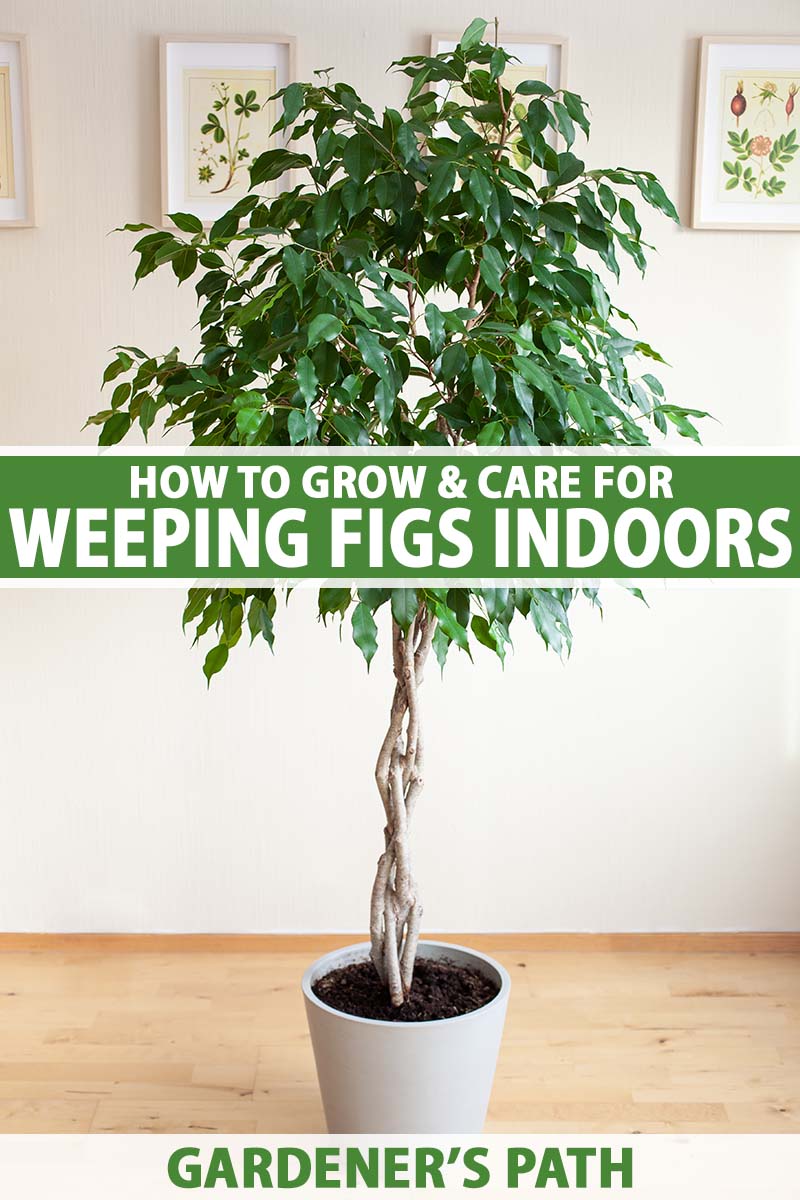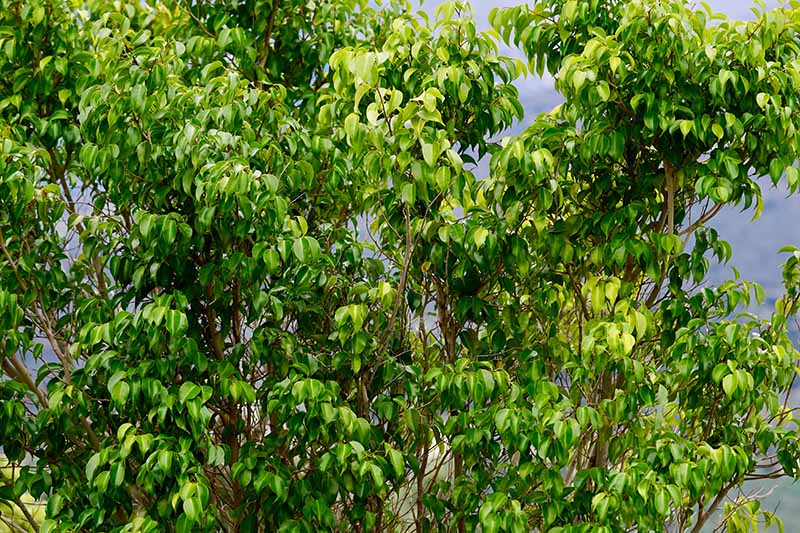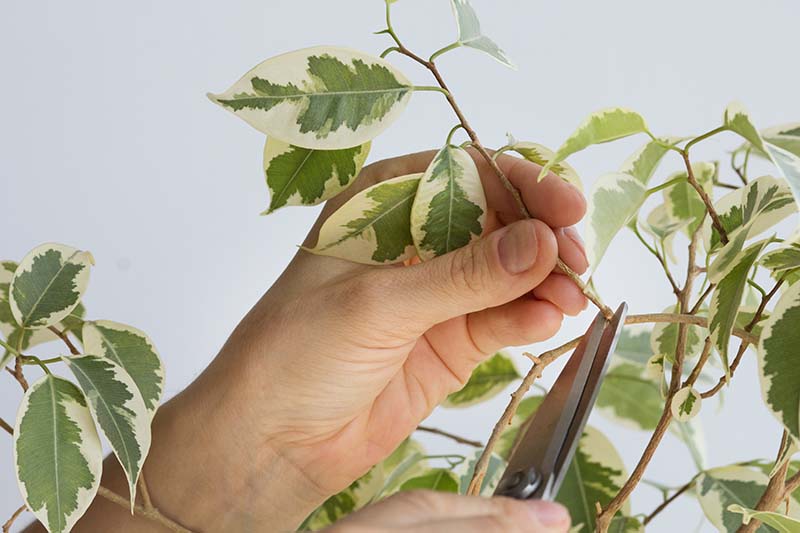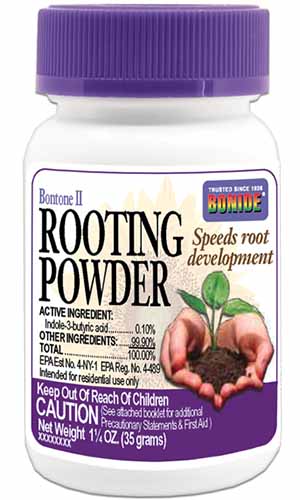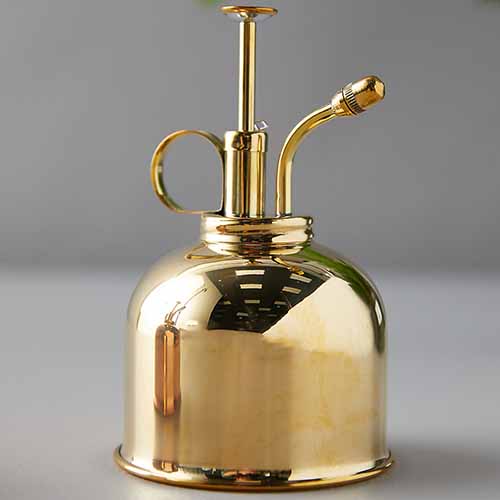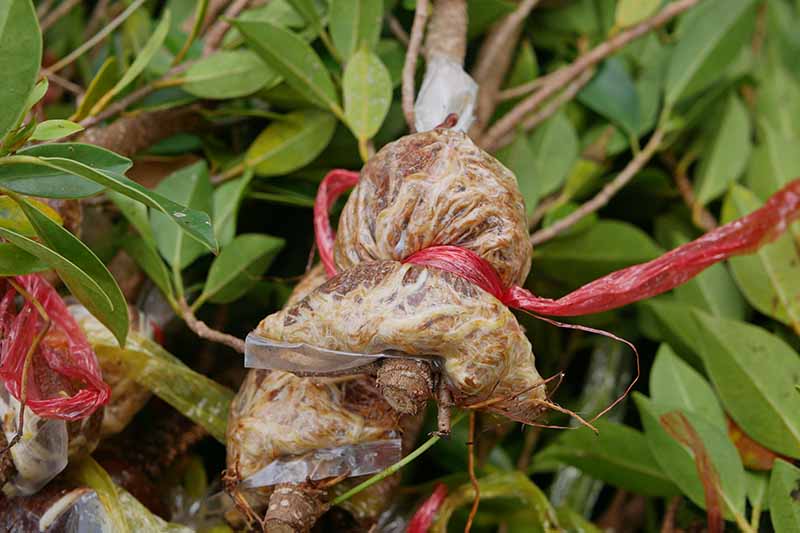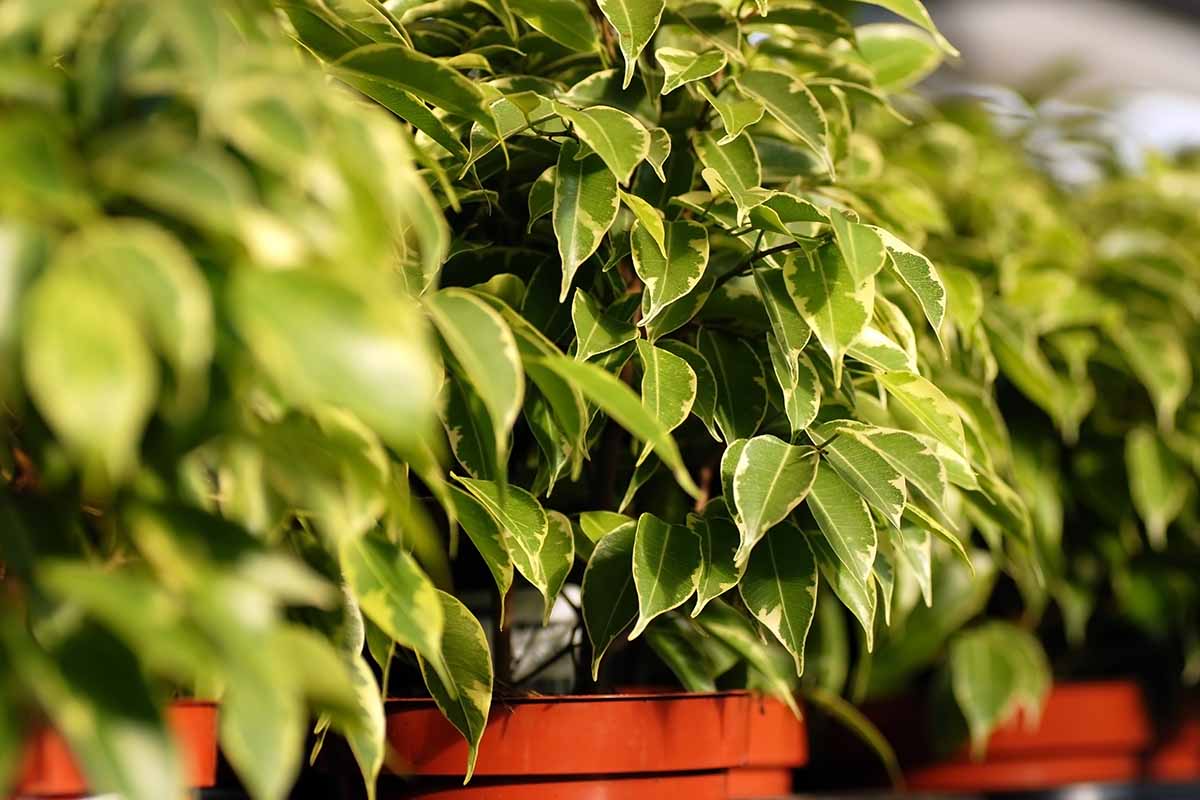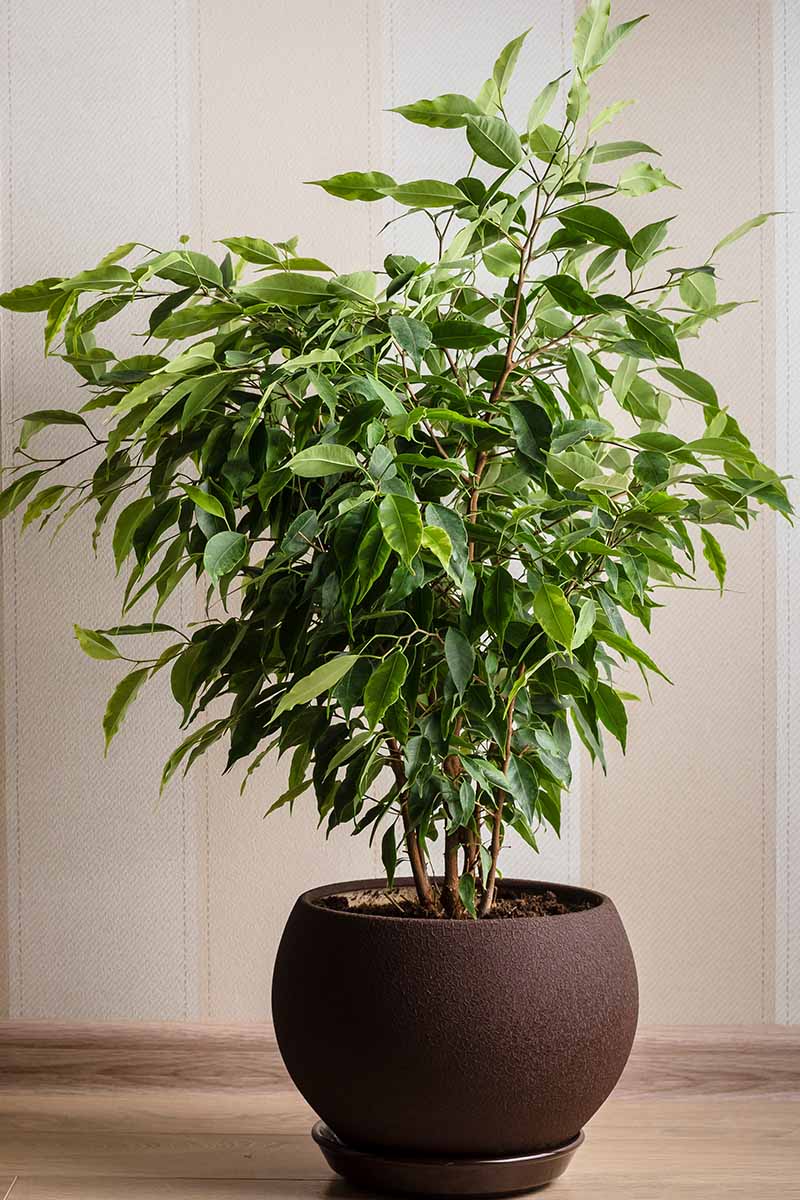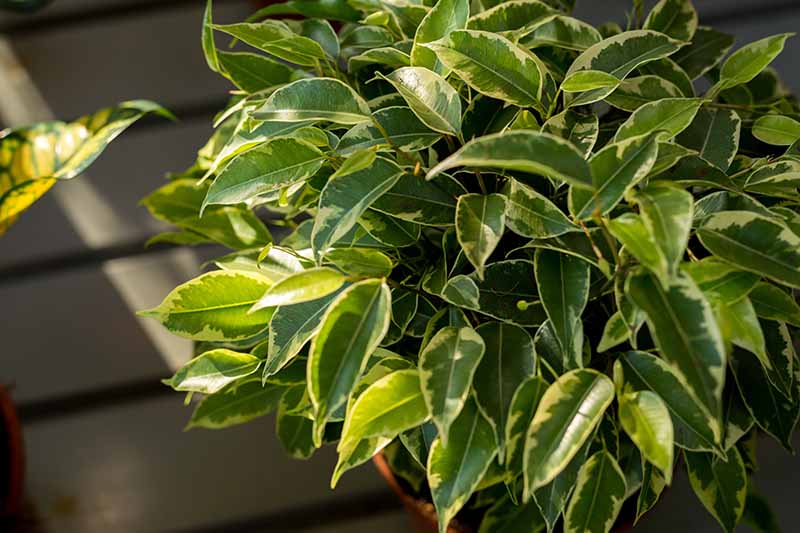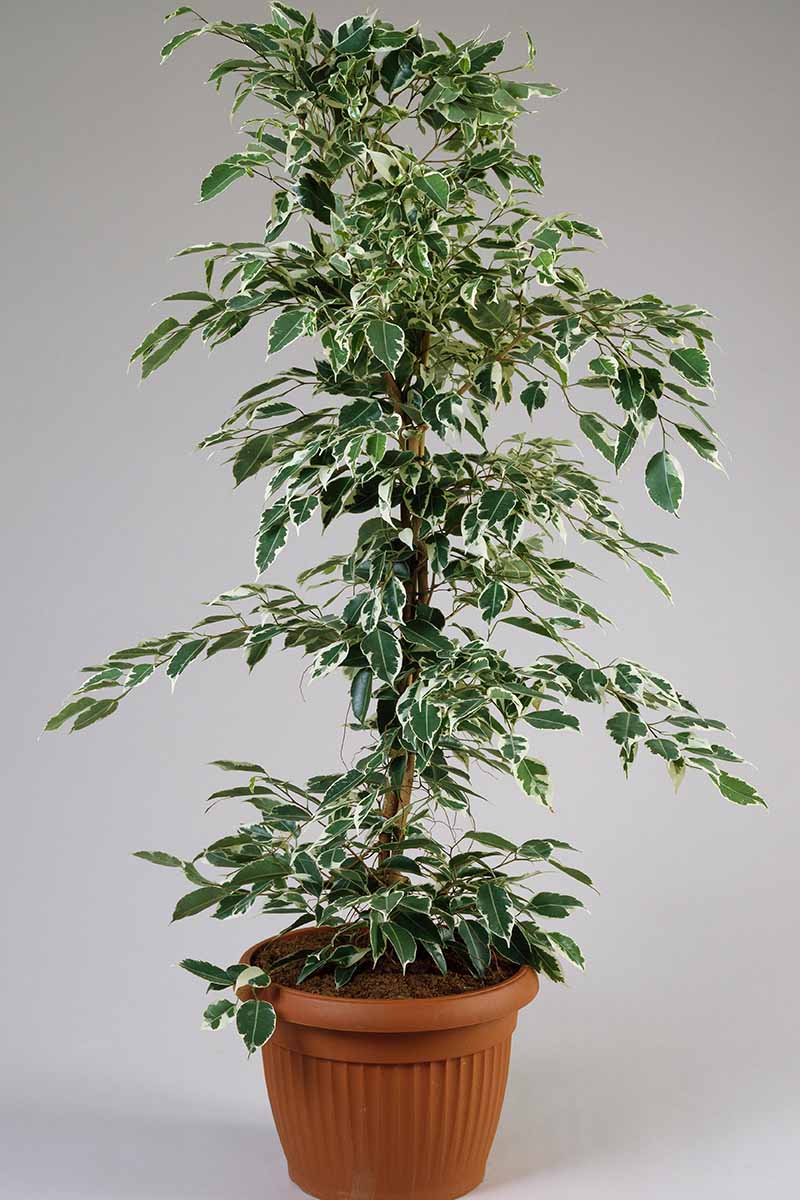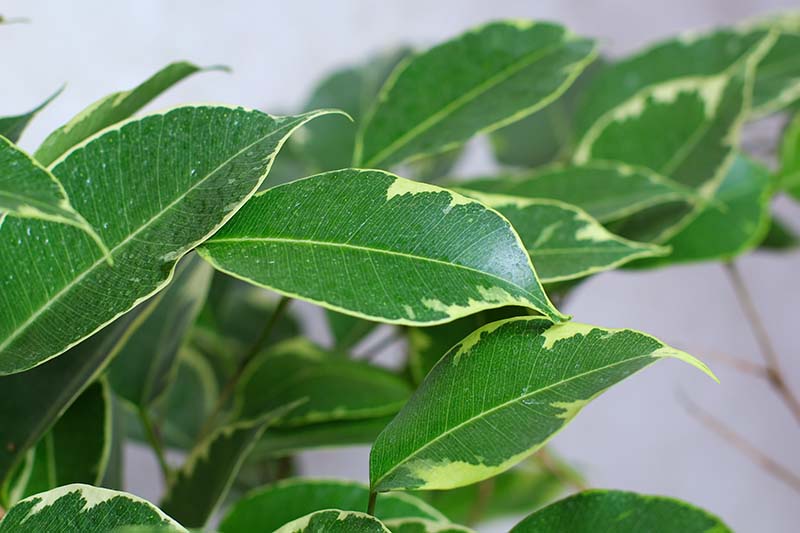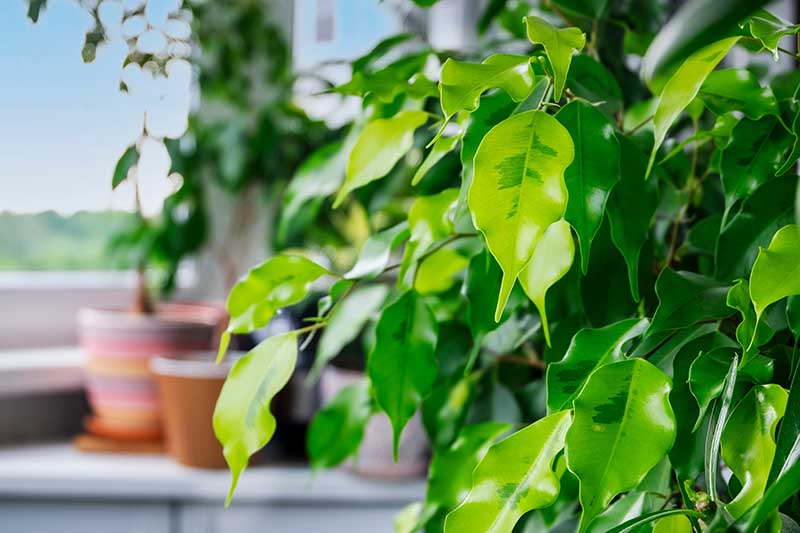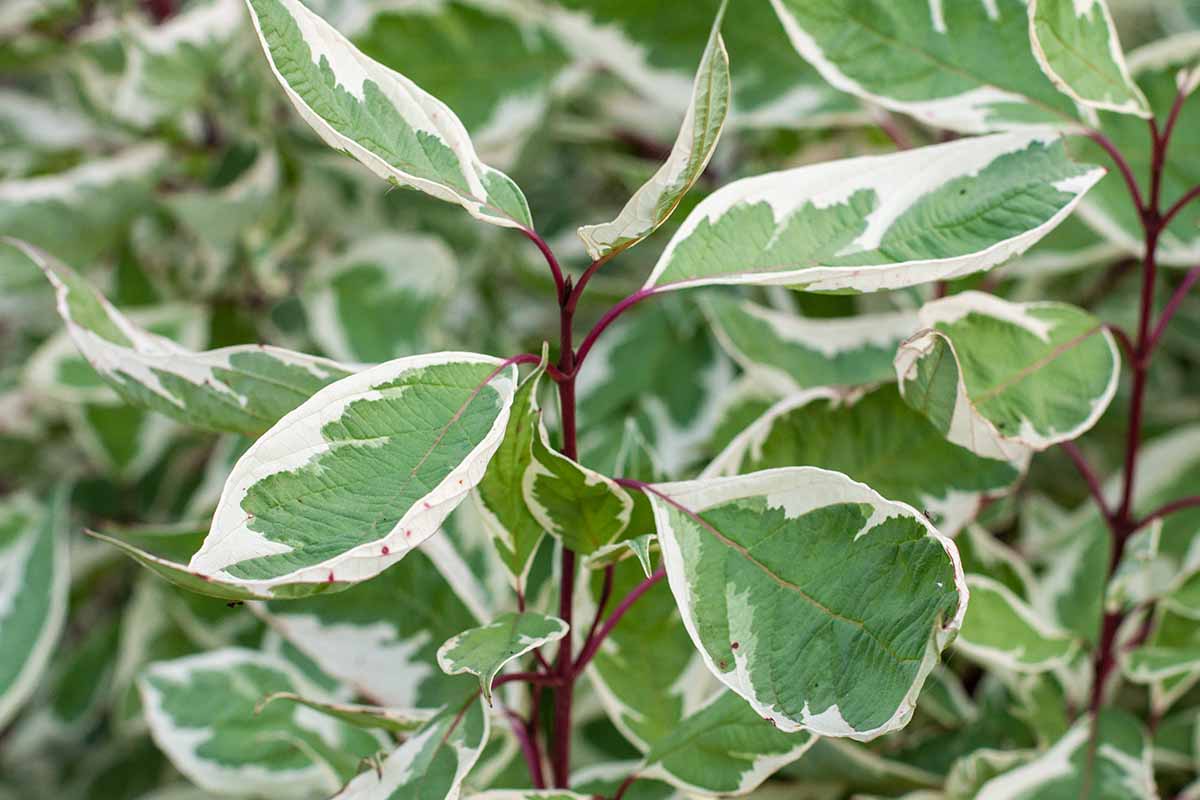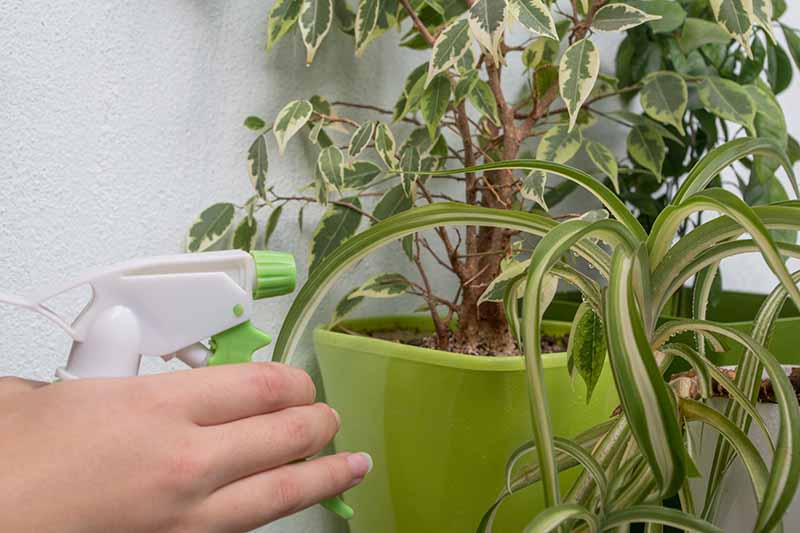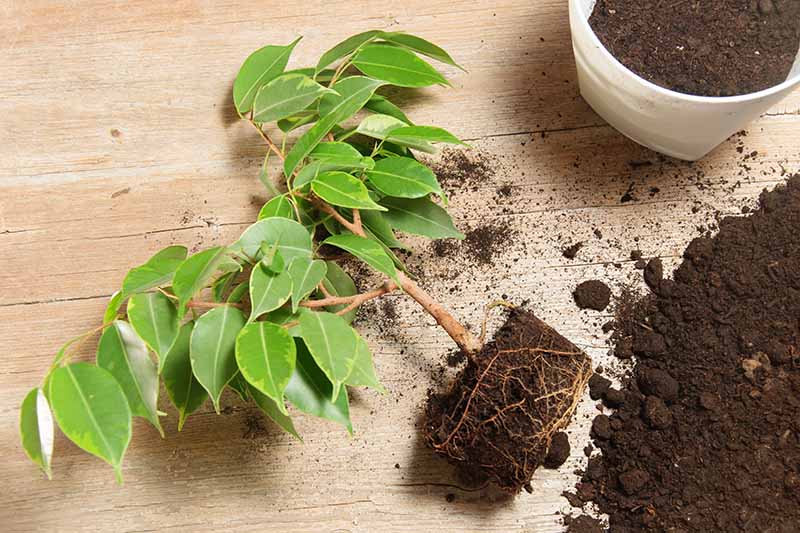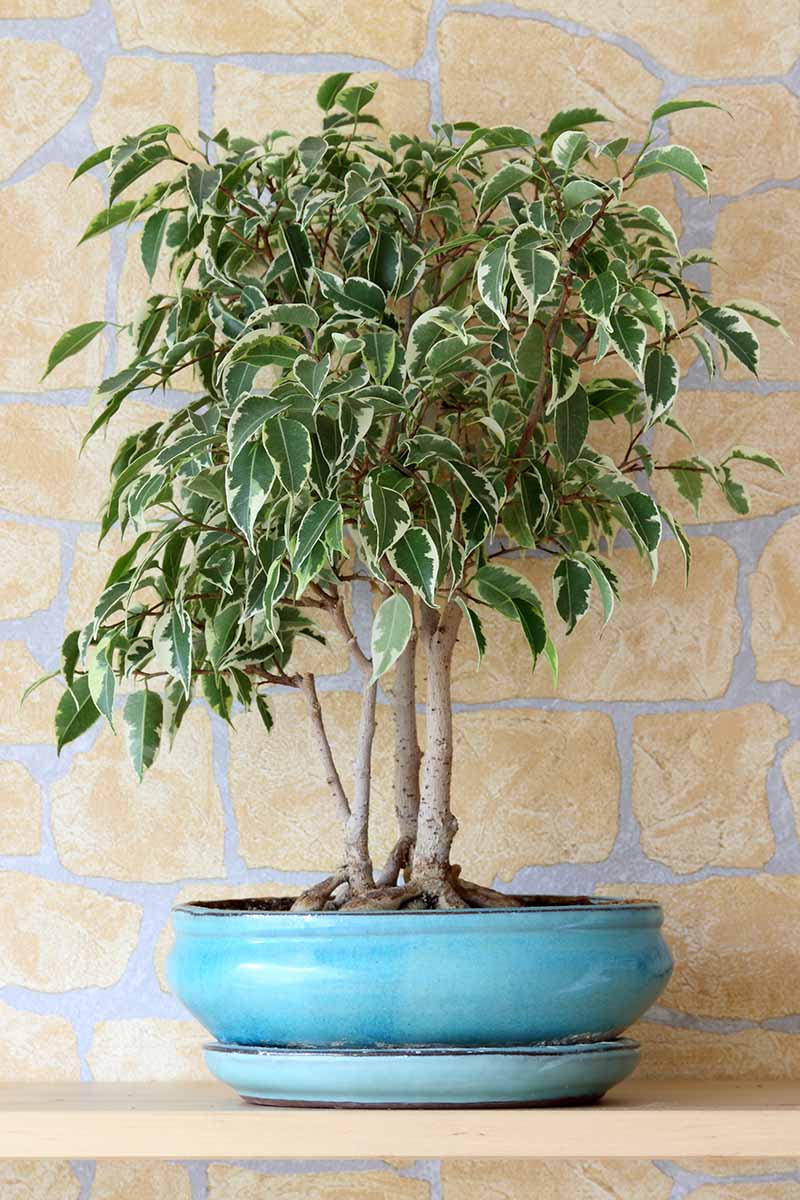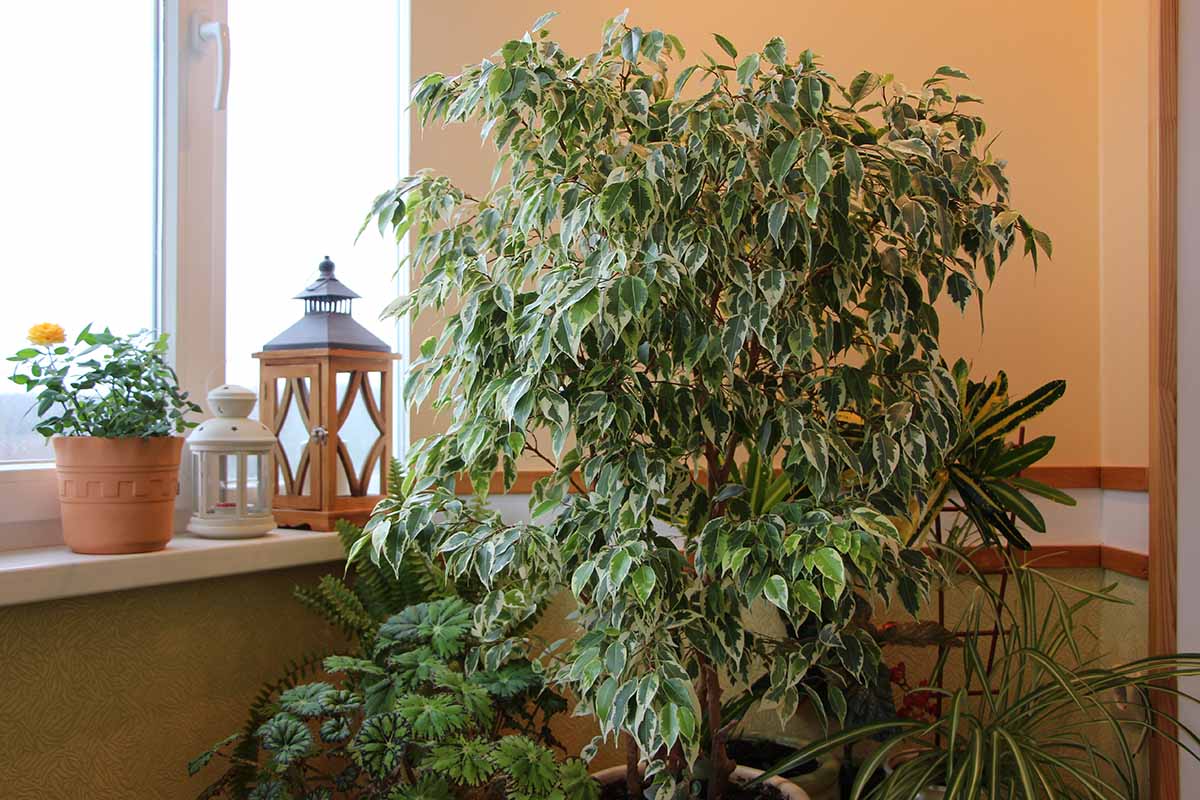With its ability to grow tall and its traditional trunk and canopy shape, it’s no wonder the weeping fig is a valued houseplant. And it makes an excellent option to fulfill this desire – with one significant caveat. Part of what makes the weeping fig so appealing, beyond its elegant shape and cascading habit, is its versatility. You can find specimens with braided or twisted stems, and plants that grow to heights ranging from just a few feet tall at maturity to 10 feet or more. The leaves can be light or dark green, or even variegated. Some even have a more upright growth habit. What all varieties have in common is that they can be a bit finicky. Shift them around from one side of your home to the other and they’ll drop their leaves. Turn the heat up in your home, and boom – leaf drop. Forget to water one week? You got it, dropping leaves. We link to vendors to help you find relevant products. If you buy from one of our links, we may earn a commission. Here’s what we’ll talk about to help you achieve weeping fig perfection: If your goal is to bring a tree into your home, you can’t go wrong with this one. It has the classic tree silhouette and is perfectly adapted to indoor living. Let’s get to know Ficus benjamina.
Cultivation and History
F. benjamina is one of the hundreds of species in the Ficus genus, a group that includes some spectacular plants, ranging from the dramatic, Jurassic-looking fiddle-leaf fig to the elegant weeping fig, with its petite leaves. It’s native to Australia, India, China, southeast Asia, and parts of the southwestern Pacific such as French Polynesia and Vanuatu. It has been introduced in warm, tropical areas like Hawaii and has become invasive in certain areas including Cuba, parts of Asia, and the Pacific Islands of Samoa and Tonga. Its scientific name doesn’t originate from someone named Benjamin but is probably a reference to benzoin, a resin that the tree produces. You can easily see where the common name weeping fig comes from since the tree has a gracefully weeping appearance. Ficus is simply Latin for fig, and you may see this species referred to by the common name benjamin fig as well. In its native habitat, F. benjamina has evolved alongside parasitic wasps that do all of the pollinating. These wasps don’t exist outside of the same warm, tropical areas where the plant grows native, with just a few exceptions. If you keep your weeping fig outdoors outside of its native range, don’t expect it to produce viable seeds. It may, however, form bright red fruits containing sterile seeds. One of the so-called strangler figs, F. benjamina starts its life in the wild in the branches of another tree. As it matures, it sends down long aerial roots that wrap around the host tree and eventually reach down to the soil. These roots grow larger and larger, and eventually act like trunks for the plant. The original host tree is often strangled to death, and as it dies back, the new ficus “trunks” take over. The ficus will often spread to surrounding trees until it becomes one massively spreading tree with multiple trunks attached to a single canopy. These types of ficus trees are commonly known as banyans.
Propagation
There are multiple ways to propagate this tree. You can purchase seeds or a sapling, take cuttings, or even use air layering. This tree is a reliable reproducer, so you can’t go wrong with any of these methods, though seeds have an extremely low germination rate.
From Seed
Though the trees may form the little pods that precede the formation of seeds, weeping figs that are grown indoors will not produce viable seeds since they won’t have access to the species of wasps that pollinate them in the wild when they are growing inside your home. In other words, you can’t harvest the immature fruit from an existing tree and use it to procure seeds for planting. However, you may be able to find seeds online. Just be careful to source your seeds from a reputable seller. Check customer reviews, make sure the seller has a generous return policy or guarantee, and don’t set your expectations too high. Germination rates, assuming you’ve even received the correct variety of seeds, are notoriously low. Because these seeds tend to be unreliable, you might want to place two or three in each container and pull all but the most robust seedling if more than one seed germinates. Plant the seeds half an inch deep in a six-inch nursery container or seed starting pot filled with potting soil, and keep the soil consistently moist but not wet. Place the pot in a spot with bright, indirect light. Viable seeds may take up to three weeks to germinate. Allow the strongest seedling to grow in place until it is at least six inches tall. At that point, you can repot it into a decorative container – provided it has adequate drainage holes – following the instructions outlined in the transplanting section below. Otherwise, you can wait to transplant until the plant begins to outgrow its pot.
From Cuttings
Cuttings can be taken during spring, summer, or fall. Before you take your cutting, prepare the container that you will place it in. Fill a six-inch container that has at least one drainage hole with a water-retentive potting medium, and poke a hole in the center with a pencil or chopstick. You’ll need one pot for each cutting. To take a cutting, use a clean, sharp pair of pruners or secateurs. Snip a six-inch cutting with at least two leaves from the end of a branch. Remove all but two of the leaves at the tip of the cutting. We do this because the cutting can’t supply a large number of leaves with the food and water that they need to survive. Too many leaves will lessen the chances that your stem cutting will produce healthy roots. If you take multiple cuttings, set them in a glass of water until you’re ready to plant. Place the container or containers somewhere warm (between 65 and 75°F) where they will receive bright, indirect light. Each day, lift the plastic and lightly mist the plant. Rooting hormone is one of those things that you should keep in your gardening kit for pro-level propagation with a higher success rate. Bonide Bontone II Rooting Powder If you don’t already have some on hand, you can find Bonide Bontone II available at Arbico Organics in 1.25-ounce containers. Water the soil well and cover the cutting with a clear plastic bag. Place a stick or other support in the container to prop up the bag so it doesn’t touch the cutting. Terrain carries lovely copper misting bottles that are ideal for this purpose. Haws Misting Bottle Then, stick your finger in the soil to see if the top half-inch has dried out. If it has, add more water to keep it moist. Within a few weeks, your cuttings should form roots. Give one a very gentle tug to see if it resists. If it does, this indicates the development of a healthy root system. Remove the plastic and continue caring for your plant as described below.
Air Layering
You’re likely to have more success with stem cuttings, but air layering is another option that’s available to home growers. While this method is less reliable, you will typically end up with larger transplants more quickly than you would with cuttings. Layering should be done in the spring, when the plant is actively growing. Select a branch that is about as thick as a pencil or chopstick and at least a foot long. Choose a layering site two to three inches from the branch tip that’s about six inches long. Remove any leaves from this section. Soak a handful of sphagnum moss in lukewarm water. Use a clean, sharp knife to cut about a third of the way through the branch. Don’t cut around the entire branch, just make the cut on one side. You want to cut through the bark and green cambium layer to reach the light-colored wood inside. Insert a toothpick into the cut to prop it open, and trim the sides of the toothpick so that they don’t stick out. Pack the moistened sphagnum moss all around the part of the branch where you made the cut. Secure the moss in place with plastic wrap. Seal the lower end of the wrap that’s closest to the joint with tape. Close the top of the plastic using a bit of string or a twist tie, so it’s easy to reopen when you need to water. Every few days, open the top section of plastic and give the moss some moisture if it feels like it is dry to the touch. If it feels any drier than a well-wrung out sponge, add water. Treat the parent tree as you would normally, according to the care instructions outlined below. After about a month, you should see roots forming in the moss. When the roots are at least two inches long, carefully remove the plastic and moss. Cut the branch away from the parent plant right below where the roots are emerging from the air layered section. Plant the rooted cutting in its own container as you would any other transplant, following the instructions outlined in the next section of this guide.
Transplanting
I’m going to warn you ahead of time so you don’t panic: when you move your plant from its nursery container to a new pot, it will probably drop some leaves. You didn’t do anything wrong, it’s just how this plant reacts to change. If you can complete this process during the winter when the plant isn’t actively growing, all the better. The best way to avoid excessive leaf drop is to do things slowly. First, place the plant in its original container in the spot where you intend to keep it in your home. Let it stay there for a week or two. Next, water the plant thoroughly the day before you intend to transplant it. Select a container that is an inch or two larger than the existing pot, and give it a good scrub if you’ve used the container before. Gently press the sides of the nursery container to loosen the root ball, and gently pull the plant out. Because F. benjamina prefers to be a little bit rootbound, you might find you need to use a sharp pair of scissors to cut down one side of the container to free the root ball. Loosen the root ball as much as possible. You want to encourage the roots to grow down and out rather than tangling up around themselves. Place the plant in the new container. If you need to add a little soil to the bottom of the container so it’s growing at the same height as it was before, do so now. Fill in around the root ball with fresh potting soil, and water well. If the soil settles, add a bit more. Weeping figs show their stress by dropping foliage. Moving it from your car to the house? You’ll see leaf drop. Shifting it from one side of the house to another? Leaf drop ensues. Repotting into a new container? Yep. Leaf drop strikes again. Burpee Premium Organic Potting Mix You can grab a nine-quart bag from Burpee.
How to Grow
Prepare yourself right now. When you bring your new green family member home, it will lose some leaves. Leaf drop is usually driven by a change in the environment, so once you find a happy place for your plant, try not to change its growing conditions. So, here is my number one tip for growing F. benjamina: don’t move it! Don’t alter its conditions, if possible. Like its cousin the fiddle-leaf fig (F. lyrata), this is a plant that doesn’t like change. If you move it, it will probably survive, but it may take weeks or months to recover. If you do move your plant or you do need to change its growing conditions, try to do so as slowly as possible. Similar to hardening off seedlings when you take them outside, you should try to ease the transition to allow your plant to acclimate very gradually. Don’t be shocked when – not if – leaf drop happens. It’s fine, so long as no more than half of the leaves fall at a time. New leaves will grow if you continue to provide proper care. But if more than that fall, the plant might die. So, what does appropriate care look like? First, let’s talk about temperature. Ideally, it should be around 75 to 85°F during the day and 60 to 75°F at night. This species can tolerate a temperature range that’s a bit wider than this, but guess what happens if the temps suddenly drop too low or climb too high? Yep, it will lose some leaves. Appropriate light exposure is another key element of growing these plants. Place yours in an area that receives lots of bright, indirect sunlight. Six to eight hours of filtered sunlight per day is just right. But any direct sun will, at best, result in leaf drop. And at worst, it could scorch or kill your plant. With too little light, growth will be thin and stunted, and the leaves will be paler than they would be otherwise. Oh yeah, and the leaves might drop in protest. Next up is moisture. These plants should be given water regularly. Allow the top two inches of the soil to dry out in between watering, except during the winter, when you can allow it to dry out by another inch. Err on the side of slightly too dry rather than too wet if you aren’t sure exactly how much water to provide or how often to get out the watering can. As with many houseplants, you should avoid watering with chlorinated or softened water. Soft water is treated in a way that increases sodium levels, which can be extremely damaging to many types of plants. If you notice white spots on the leaves, it’s likely a build-up of residue from the minerals and chemicals found in municipal water. In this case, flush your soil with filtered water or remove and replace the soil in the container. Wipe off the white spots with a solution of one part white vinegar mixed with 10 parts water. You should always water your houseplant at the soil level rather than on the foliage. F. benjamina won’t survive if it has roots that are constantly wet. Always use a container that has at least one drainage hole, and select one that is only an inch or two larger than the previous pot when you transplant.
Growing Tips
Provide bright, indirect light.Maintain consistent temperature.Introduce change gradually.Apply a slow-release fertilizer in the spring.
Pruning and Maintenance
All houseplants go through a period where they go dormant and stop growing for a time. But they don’t drop their leaves like deciduous plants outdoors do. Aquatic Arts Indoor Plant Fertilizer Apply it in the spring, following the manufacturer’s directions. However, weeping figs may actually drop their leaves in the winter, despite being classified as evergreens. They don’t typically drop all of their leaves and go completely bare during this period – it’s usually more of a leaf-thinning situation instead. It can be very hard to tell whether your tree is dropping leaves because of shock or a change in the environment, or if it’s seasonal. In the fall, if you haven’t changed its growing conditions or maintenance schedule recently, then it’s safe to assume that the leaf drop is just seasonal, particularly if only a few leaves drop. If this is the case, stop fertilizing and reduce the amount of water you’ve been providing. Your plant doesn’t need as much water or any food during this time, since it is essentially resting. When new leaves start to emerge in the spring, return to your regular watering and feeding schedule. When grown year-round outdoors in warmer regions, weeping figs can handle quite a bit of pruning, but specimens that are grown indoors are another matter altogether. You can absolutely trim back an unruly plant and remove any leggy, dead, or diseased branches, but be sure to do it slowly. Prioritize removing any diseased or dead parts first, and then you can remove up to 10 percent of the remaining branches at a time. Allow the tree to recover for at least six months before pruning again. Ideally, all pruning should be done in the fall or winter, but you should remove diseased material quickly whenever it pops up. Make your cuts using a clean, sharp pair of pruners and snip near a leaf node. If any aerial roots form, feel free to prune these away. You should repot your plant when it becomes rootbound to the point where you can see roots circling the surface of the soil or coming out of the drainage hole. At that point, remove it from the pot, brush away as much of the soil as possible, and repot it in a container that’s one or two inches larger than the current one. These figs do better when they are slightly rootbound rather than being moved to a container that is too large. Some growers like to move their plants outdoors during the warm months, and you can certainly do this with weeping figs, if you’d like. But be aware that they will drop leaves each time you move them. Be sure to move them gradually, to give the plants time to acclimate to the outdoor environment. Bring the plant outside to a protected spot for an hour or so on the first day, and gradually increase the amount of time the plant spends outdoors over the course of a week. You’ll need to reverse this process in the fall when you bring the plant back indoors.
Bushy King
‘Bushy King’ has leaves with yellow margins and a compact, dense habit. The leaves are more petite than those of the species plant. Benjamin Ficus with Braided Trunk For instance, you can find a species plant in a three-gallon pot with a braided trunk available from Fast Growing Trees. But specialty retailers and nurseries often carry unique and attractive cultivars featuring variegated foliage, dwarf sizes, and extremely compact growing habits. In the case of weeping figs, “compact growth habit” refers to how tightly packed the leaves are, not the size of the plant. Some are ideal for bonsai, while others are better off growing in a suitable climate outdoors. Speaking of which, if you wish to grow yours outside, check out our guide to growing weeping figs outdoors. Indoors, it stays under six feet tall, but outdoors this cultivar can grow 14 feet tall and wide in Zones 9 to 11. This variety is the result of a ‘Golden King’ mutation that was cultivated by growers to be sold commercially.
Bushy Prince
As is often the case with any lesser royal – at least where plants are concerned – ‘Bushy Prince’ is more diminutive than its relative ‘Bushy King.’ This variety generally stays under 12 feet tall and eight feet wide at maturity if grown outside, but closer to six feet tall and four feet wide indoors. The leaves are solid, glossy, medium green, and proportionally smaller than those of other types.
Danielle
Sometimes called Daniella ficus, the dark green foliage and pale tan branches of this cultivar are produced in a more upright fashion than what you’ll see on most others, which generally live up to the weeping moniker. ‘Danielle’ stays under six feet tall and spreads about three feet wide at maturity.
De Gantel
‘De Gantel’ is a beauty with heavily variegated gray-green leaves with creamy white accents. It rarely grows more than five feet tall and has a somewhat columnar growth habit, spreading about two and a half feet wide.
Exotica
This cultivar has lighter foliage than most others, and its weeping growth habit is exaggerated. But what makes it truly special is the way that each leaf twists slightly. It’s a marvel to watch the foliage dance in a light breeze. ‘Exotica’ has a rounded shape, growing up to nine feet tall and wide, and twice that outdoors. This cultivar is slightly more frost tender than most, and should only be grown outdoors year-round in Zones 10 and 11.
Golden King
The foliage on ‘Golden King’ is striking. The leaves are variegated with distinct light green margins and medium green midribs. Ideal if you have a limited amount of space, this type only reaches four feet tall and two feet wide.
Golden Monique
Combine the size of the plant and the narrow, rippling leaves of ‘Monique’ with the golden and green coloring of ‘Reginald’ and you have ‘Golden Monique.’ This plant is less prone to leaf drop, but the characteristic coloring only develops in bright, indirect light. Otherwise, it remains medium green. This variety grows well in Zones 10 to 11 if you wish to plant one outdoors. Indoors, ‘Golden Monique’ will top out at four to five feet tall, and can grow up to 10 feet tall outdoors.
Judith
‘Judith’ has petite leaves that are distinctly variegated, with medium green and creamy yellow splotches. If you are looking for a weeping fig to feature in a dimly lit part of your home, this is an excellent option. This one doesn’t drop its leaves as readily or as heavily as many others, as an added bonus. It’s a standard-sized weeping fig, so expect a mature height of about six feet or so indoors, depending on the growing conditions.
Midnight
A mutation of ‘Exotica,’ ‘Midnight’ has dark green leaves, but otherwise it looks like its parent, with a similar height and spread of nine feet tall and wide, and double that outdoors. It’s extremely resistant to leaf drop, making it an excellent option for benjamin fig beginners.
Monique
On lovely ‘Monique,’ the deep green leaves are more narrow than those of most other cultivars and the margins feature heavy rippling, with light and dark green variation. ‘Monique’ is less prone to leaf drop than many other types, and it grows well outdoors in Zones 10 to 11. This cultivar will reach a mature height of four to five feet tall when grown indoors.
Reginald
‘Reginald’ was initially a happy accident, emerging after a grower named Reginald Deroose discovered a mutation on an ‘Exotica’ plant in Belgium, in 1986. With its variegated leaves, featuring bright yellow gold mixed with dark green mid-veins, coupled with an extremely heavy weeping growth habit, this plant looks like a fountain bubbling with gold and green. Leaves growing on the interior and plants kept in darker locations tend to be primarily dark green, while mature leaves and plants exposed to bright light are more yellow. This is a standard-sized weeping fig, so expect it to reach around six feet tall indoors.
Starlight
‘Starlight’ shines bright with its vibrant yellow and green variegated leaves.
Too Little
‘Too Little’ is an adorable dwarf cultivar that is incredibly popular in the bonsai world. The leaves, stems, and trunk are all proportionally tiny, so the tree appears to be a completely miniaturized version of the standard species. This cultivar grows well outdoors in Zones 9 to 11 as a shrub or small tree that will stay under 12 feet tall. ‘Starlight’ Note that the leaves of this cultivar can sometimes revert back to a larger size like that of the species plant, so prune any branches you see that have produced full-sized leaves if you’d like to keep the smaller foliage.
Wasana
This cultivar is often used in creating bonsai as well. The leaves are extremely small and variegated, with white margins. ‘Wasana’ plants stay under a few feet tall naturally, but of course, they can be limited further by growing in a bonsai container.
Wintergreen
‘Wintergreen’ has deep, dark, glossy green leaves. Despite the fact that it stays compact at under six feet tall when grown in a container indoors, the leaves are as large as those of a standard-sized weeping fig. This cultivar also grows well outside as a dwarf specimen in Zones 9 to 11, where it will grow about twice as tall.
Managing Pests and Disease
While leaf drop due to changing environmental conditions is far more likely to cause problems for your plant than any other issue, you might also bump up against a few insects. Disease pathogens come to call even less often, but it’s still a good idea to be aware of the potential culprits.
Insects
Indoor pests lack natural predators, which allows them to spread pretty much unchecked. What’s one of the most common symptoms of a pest infestation? I’ll give you one guess… If you said dropping leaves, you win! There are a few common pests that you’ll see on indoor plants.
Aphids
Aphids are extremely common. A large infestation can cause leaf drop and yellow stippling on the leaves. You will most commonly see them on the green growing tips of ficus plants, but they can feed anywhere. The most common species found indoors is the green peach aphid (Myzus persicae). Spraying regularly with neem oil is a standard method for dealing with these pests. Because they’re so common, you should be sure to learn how to spot and eliminate these pests if you haven’t already. Our article on how to deal with aphids provides helpful information to guide you through the process.
Mealybugs
Mealybugs, insects in the family Pseudococcidae, are another common type of houseplant pest. They will feed on ficus plants, using their piercing mouthparts to draw sap out of the tree. When they congregate in groups, these little wingless insects are covered in a waxy coating that makes them look more like some type of fungal disease than a pest infestation. For more information on identifying and dealing with mealybugs, read our guide.
Scale
Scale insects attack both indoor and outdoor ficus trees. There are hundreds of species that might feed on your plant, all from the order Hemiptera, but you can deal with each of them in the same way. If your tree starts dropping leaves, look for little brown or black lumps on the leaves, stems, or trunk. These are the insects. To rid your plant of them, wipe each insect with a cotton swab that has been dunked in a bit of rubbing alcohol. It’s a little tedious, and you will need to do it again every few days over the course of a few weeks, but it’s effective. For more tips, check out our guide to scale.
Spider Mites
Spider mites love dry conditions, and it just so happens that home interiors tend to be drier than the outdoors. These tiny spider relatives will suck on your plants to feed, and they leave behind extremely fine webbing – which is usually what will first tip you off to an infestation. The red spider mite (Tetranychus spp.) is the most common. Learn more about how to deal with these teeny-tiny pests in our guide.
Disease
F. benjamina is rarely troubled by disease. Rotting roots are really the only thing you need to watch for.
Root Rot
Root rot can be caused by two issues. The first is standing water around the roots, and the second is disease. More specifically, root rot is caused by the fungi Rhizoctonia solani and Fusarium oxysporum. Both of these species thrive in oversaturated soil – so in other words, don’t overwater your ficus! Be sure to use a container that has at least one drainage hole, and empty the catchment pot or drainage saucer about half an hour after watering. Allow the top two inches of soil to dry out before watering again, and provide even less water in the winter. Because it’s impossible to tell with the naked eye whether this ailment has been caused by a fungus or whether the roots are simply drowning in too much water, you’ll need to treat for both probable causes. First, remove the plant from the pot and rinse away all of the soil. Trim away any mushy or black roots. Next, treat the roots with a biofungicide. Mycostop is an excellent option that’s very effective. Mix it with water according to the manufacturer’s directions and spray the roots. Wipe the container clean and sanitize it with a 1:10 mixture of bleach and water (one part bleach to nine parts water). Fill it with fresh potting soil.
Best Uses
F. benjamina is a beautiful option for bonsai because it is one of those few trees that can stay indoors all year-round, but it’s also lovely when planted in a small group in a single container, usually with the stems braided together. Mycostop Biofungicide Mycostop is effective against a number of different fungal diseases, so it’s handy to keep around. Pick some up in five- or 25-gram packets at Arbico Organics. And of course, it’s perfect as a single specimen in a container as well. Hopefully this guide has put you on the road to success with this elegant houseplant. Knowing what to watch for, and what to avoid, goes a long way towards making your plant happy. Are you growing a weeping fig? If so, have you had any trouble with leaf drop? What caused it? Let us know in the comments below so we can share our experiences! If you’d like to add a few more houseplants to your collection, you might be interested in some of our other guides next:
How to Grow and Care for Rubber TreesHow to Grow and Care for Elegant Lady PalmsHow to Grow and Care for Anthurium Houseplants
